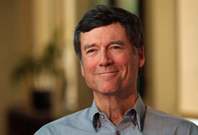.jpg) Effective philanthropy requires adapting one's strategy to achieve success. Perhaps surprisingly, this may be as true in the area of conservation as it is for other philanthropic causes. Steve McCormick knows this truth well.
Effective philanthropy requires adapting one's strategy to achieve success. Perhaps surprisingly, this may be as true in the area of conservation as it is for other philanthropic causes. Steve McCormick knows this truth well.
McCormick has focused his life’s work in large part on conservation, first at The Nature Conservancy, where he began working in 1976 and led from 2001 to 2007, and now as President of the Gordon and Betty Moore Foundation. In the past, McCormick says that the idea of conservation has been largely centered on setting aside lands and "locking them up." Unfortunately, he says that idea creates a Pyrrhic victory and, in many areas of the globe, is seen as taking resources away from people. Over the last decade, says McCormick, conservation is evolving "to look at how food and water and energy are produced and to try to do that in a way—and there is technology emerging—that can accommodate the functioning of natural systems, as well as human needs."
McCormick’s brand of philanthropy is refocusing and adapting in just this way. In his video interview with Bridgespan, McCormick shared the story of how the Moore Foundation’s work to conserve the Amazon changed; essentially moving “from looking at how many hectares we’ve set aside to how effective we are at reducing rates of deforestation.” Why the shift? McCormick reports that, when the foundation set a goal to protect 70% of the Amazon basin, a percentage that researchers had determined would ensure its climactic and hydrologic integrity, the goal resulted in incentives to focus on protecting as much land as possible, “and so a lot of the early success was on creating protected areas deep in the heart of the Amazon, which frankly weren’t all that threatened.”
See the complete archive of Steve McCormick videos.
A threat that did begin to emerge? "Over time, what we saw was significant change in land use practices on what we could call the sort of frontiers of the forest, meaning the interface of human use and intact forest," says McCormick. "Those land-use changes were around massive conversion of forests into soy and other agricultural crops and cutting of the forest for cattle." Moreover, the Brazilian government offered incentives to encourage deforestation for these commercial interests. McCormick says, “We’d missed the whole need to work in the policy arena.” In response, McCormick and the Gordon and Betty Moore Foundation adapted its goal of strict conservation to focus on sustainable land practices, which requires a slew of interrelated efforts around, for example, timber harvestry and preventing sedimentation on agricultural lands, to name just two areas. Creating sustainable land practices requires "a much more complex approach than simply setting aside land," says McCormick.
Luckily, at the Moore Foundation, McCormick has felt empowered to take the risks inherent in adapting his approach. "One of the most rewarding things is…the freedom that we have to try things that are just out of the box, to think of an idea that could really change the world, and to think through how that idea could be turned into action with nothing in our way—nothing to set us back but our own sense of limitation and our own hesitation.”
Steve McCormick's Key Messages for Philanthropists
- Balance family involvement with outside expertise in family foundation governance. Watch: Steve McCormick talks family involvement at the Moore Foundation.
- Foundations are obligated to take risks that can be “game changers” for society, including long-term investments and quick big bets. Watch: “Quick strikes” and “patient capital”: Steve McCormick sees foundations doing two things nothing else can.
- Foundations that fail to collaborate are less effective and impose unnecessary costs on nonprofits. Watch: Advice from a former grant seeker: Steve McCormick urges foundations to understand grantees better and to collaborate by sector.
- Environmental conservation is critical not only for nature but to preserve human well-being and meet human needs. Watch: Conservation’s “extraordinary transformation”: Steve McCormick on making a theory a reality.


